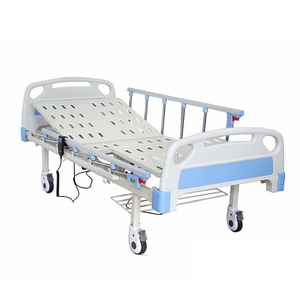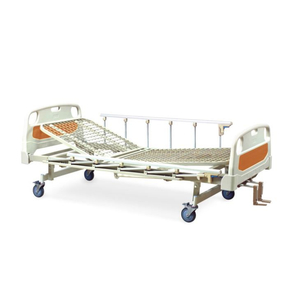In the healthcare industry, ensuring patient comfort is a top priority, especially for those who spend extended periods in a hospital bed. Hospital beds are designed not only to provide medical support but also to offer comfort and ease of use for both patients and caregivers. However, the question remains: how can we make a hospital bed more comfortable? This article will explore various strategies and innovations that can enhance the comfort of hospital beds, focusing on factors such as mattress quality, bed adjustability, and additional accessories. By understanding these elements, manufacturers, distributors, and healthcare providers can make informed decisions to improve patient care.
For manufacturers and distributors, understanding the importance of comfort in hospital beds is crucial. By integrating advanced features and materials, they can meet the increasing demand for more comfortable and functional hospital beds. In this article, we will also provide insights into the latest trends and technologies that are shaping the future of hospital bed design. For more information on hospital bed solutions, you can explore the Hospital Bed section on our website.
Factors Influencing Hospital Bed Comfort
1. Mattress Quality
The mattress is one of the most critical components in determining the comfort of a hospital bed. A high-quality mattress can significantly reduce the risk of pressure ulcers and provide better support for patients. There are several types of mattresses available for hospital beds, including foam, air, and hybrid mattresses. Each type has its advantages, and the choice of mattress should be based on the patient’s specific needs.
For instance, foam mattresses are known for their ability to distribute weight evenly, which helps in reducing pressure points. Air mattresses, on the other hand, offer adjustable firmness, making them ideal for patients who require frequent repositioning. Hybrid mattresses combine the benefits of both foam and air mattresses, providing a balance between support and comfort. For more details on hospital bed mattresses, visit our Hospital Bed Mattress page.
2. Bed Adjustability
Adjustability is another key factor that contributes to the comfort of a hospital bed. Beds that offer multiple adjustable positions can help patients find the most comfortable posture, whether they are sleeping, sitting up, or reclining. Adjustable beds also allow caregivers to position patients in ways that reduce the risk of bedsores and improve circulation.
Modern hospital beds come with features such as electric controls, which allow patients to adjust the bed's height, headrest, and footrest with ease. This not only enhances comfort but also provides greater independence for patients. Additionally, some beds are equipped with memory functions that can save preferred positions, making it easier for patients to return to their most comfortable setting. To explore more about adjustable hospital beds, check out our Electric Hospital Bed collection.
3. Pressure Relief Features
Pressure relief is a critical aspect of hospital bed comfort, especially for patients who are bedridden for long periods. Pressure ulcers, also known as bedsores, can develop when patients remain in the same position for too long. To prevent this, hospital beds can be equipped with pressure-relieving features such as alternating pressure mattresses or air cushions.
These features work by redistributing the patient's weight and reducing pressure on vulnerable areas such as the hips, back, and heels. Some advanced beds also come with sensors that monitor the patient’s movements and automatically adjust the mattress to prevent pressure buildup. For patients at high risk of developing pressure ulcers, investing in a bed with these features is essential for both comfort and health.
4. Temperature Regulation
Temperature regulation is another important factor in making a hospital bed more comfortable. Patients who are bedridden often experience temperature fluctuations, which can lead to discomfort. To address this issue, some hospital beds are equipped with temperature-regulating mattresses or bedding materials that help maintain a consistent temperature.
These materials are designed to wick away moisture and provide better airflow, ensuring that patients remain cool in the summer and warm in the winter. Temperature regulation can significantly improve the overall comfort of a hospital bed, especially for patients with conditions that affect their body temperature regulation.
5. Additional Accessories
In addition to the bed and mattress, various accessories can enhance the comfort of a hospital bed. These include items such as bed rails, overbed tables, and specialized pillows. Bed rails provide safety and support for patients, while overbed tables allow them to eat, read, or use electronic devices comfortably while in bed.
Specialized pillows, such as wedge pillows or lumbar supports, can also improve comfort by providing additional support to specific areas of the body. These accessories are especially useful for patients who have difficulty moving or require assistance with daily activities. For a comprehensive range of hospital bed accessories, visit our Wheelchair Accessories section.
Innovations in Hospital Bed Design
1. Smart Hospital Beds
The integration of smart technology into hospital beds is revolutionizing patient care. Smart hospital beds are equipped with sensors and monitoring systems that track the patient’s vital signs, movements, and sleep patterns. This data can be used to adjust the bed’s settings automatically, ensuring optimal comfort and support.
For example, some smart beds can detect when a patient is about to get out of bed and alert caregivers to prevent falls. Others can monitor the patient’s heart rate and breathing patterns, providing real-time data to healthcare providers. These innovations not only enhance comfort but also improve patient safety and care.
2. Modular Bed Systems
Modular bed systems offer flexibility and customization, allowing healthcare providers to adapt the bed to the patient’s specific needs. These beds are designed with interchangeable components, such as headboards, footboards, and side rails, which can be easily replaced or upgraded as needed.
This modular approach not only enhances comfort but also extends the lifespan of the bed, making it a cost-effective solution for hospitals and care facilities. For more information on modular hospital bed designs, visit our Hospital Bed Design page.
3. Eco-Friendly Materials
Sustainability is becoming an important consideration in hospital bed design. Manufacturers are increasingly using eco-friendly materials, such as organic cotton and recycled metals, to reduce the environmental impact of hospital beds. These materials are not only better for the environment but also offer improved comfort and durability.
For example, mattresses made from natural latex or organic cotton are hypoallergenic and provide better breathability, making them more comfortable for patients with sensitive skin or allergies. By choosing hospital beds made from sustainable materials, healthcare providers can contribute to a greener future while ensuring patient comfort.
In conclusion, making a hospital bed more comfortable involves a combination of factors, including mattress quality, bed adjustability, pressure relief features, temperature regulation, and additional accessories. By incorporating these elements, manufacturers and healthcare providers can significantly enhance patient comfort and well-being.
Innovations such as smart beds, modular systems, and eco-friendly materials are also playing a crucial role in shaping the future of hospital bed design. For those looking to invest in high-quality hospital beds, exploring the latest technologies and materials is essential. To learn more about our range of hospital beds and accessories, visit our Hospital Bed section.





















